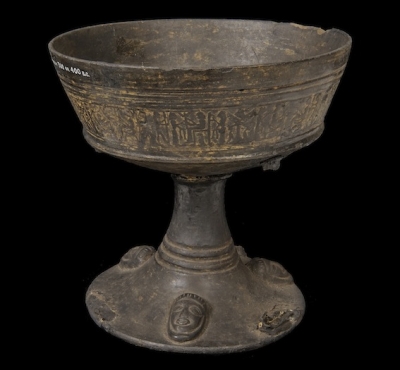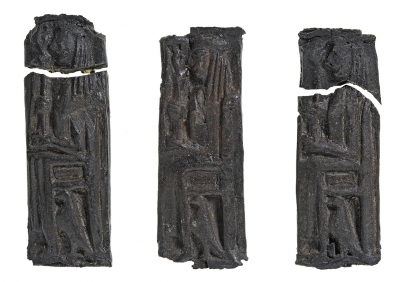To search the RPR site click here
Etruscan chalice
from Chiusi 1884.37.83
Lucy Shipley, University of Southampton
This object is an Etruscan ceramic vessel, made of bucchero, the signature ceramic style of the Etruscan world, with the characteristic black sheen this type of ceramic is famous for. This style of pottery is thought to have been deliberately designed to mimic the effect of metal dining ware for a fraction of the cost. However, this vessel is a little different from the other examples of buccheroid chalices to be found in collections all over the world: firstly, in its form, and secondly, in its location, as it resides within the Pitt Rivers Museum, Oxford.
When this museum is mentioned, what comes to mind? The vision of Augustus Henry Lane Fox Pitt Rivers himself, striding across a landscape dotted with perfectly regular trenches measured in intricate grid squares? The cabinet of curiosities which forms the main galleries, a joyous maze of archaeological and anthropological materials, where at every turn a new artefact catches the eye: a shark's tooth amulet, a samurai sword, a gaping mask, a strange and intriguing musical instrument. The archaeology of the Mediterranean Iron Age certainly does not, yet the vociferous collecting of Pitt Rivers and other donors has resulted in just such material being included within the museum's possessions. This bucchero vessel is, however, part of Pitt Rivers' own founding collection, and while there is little information attached to it detailing how it came to be found in this archaeological treasure chest, I would suggest that it came via an antiquities dealer, as during the late 19th century, in the wake of early excavations at Vulci and Caere, the activities of tomboroli, or grave robbers, in Tuscany, Umbria and Lazio became more intense, in response to the increase in interest and value of Etruscan material. This is confirmed by the composite nature of the vessel: the bowl is from one object, while the stem and base are from another. This vessel is labelled as being from “Toscana, provincia di Siena, Chiusi,” which I would suggest is an accurate description of the findspot for both halves of the vessel. Chiusi, and the neighbouring city of Cetona, were both large Etruscan centres, with Chiusi in particular being known for its production of high quality bucchero wares. Some of the more intricate stylistic elements of the two halves of this vessel also strongly support the original provenance supplied by the label. However, there is no idea of where the vessels came from more specifically, although I suspect they originate from the Poggio Renzo necropolis at Chiusi. Whichever of the numerous tombs of Poggio Renzo the vessels came from, perhaps imported alongside the Etruscan helmets and bronzes mentioned in the Hebdomadal Council review of the collection in 1883, in the most recent phase of its biography, the two pieces, brought together by antiquities dealers and delivered to Oxford, lay, carefully shrouded in protective wrappings, in a cardboard box, labelled simply “ceramic.”
It is at this point that the form of the vessel comes to the fore: for this is not simply another piece of ceramic, another fragmentary pot to be consigned to the back room, while the flashy metal artefacts it arrived with are placed out in the gallery: as I unwrapped the fragments of this vessel, it quickly became apparent that it was not only beautiful, as so many buccheroid ceramics are, but also rather unusual. The lower half of the vessel is in fact a caryatid chalice, of Rasmussen Type 1b (Rasmussen 2006:95), which although chipped, battered and bruised, is very much still recognisable as such. The upper part of the chalice, an open form bowl, displays a cylinder-made decoration frieze (a type of decorative technique particularly associated with Chiusi (Minetti 2004) which shows a scene of seated figures, standing attendants and a winged divinity, repeated around the entire outer surface of the chalice, and seems to be of Rasmussen Type 2e (Rasmussen ibid: 190). Some individuals are accompanied by birds, and some carry a lituus, or curved staff, which has been seen as a symbol of the Etruscan elite or ruling class. The lower part of the vessel, its stand and base, with mould made supports in the shape of more seated female figures, who are familiar from the cylinder frieze, is reminiscent of the images from the upper pot, and perhaps explains why the two were placed together. Caryatid chalices generally depict standing individuals, while this representation of seated figures recalls strongly the processional scenes from other Etruscan artefacts, such as the frieze plaques from Poggio Civitate (Gantz 1971). In a further reference to the cylinder frieze, these female figures (recognisable as such from their dress, hairstyle and bodily representation) are accompanied by birds, and seated on backed chairs. On the base of the chalice, between the broken remnants of where these caryatid supports were placed, are male bearded heads, creating a series of six couples: three male faces, and three female sitters.
I would suggest that these two objects were probably taken from elite tombs in the Poggio Renzo necropolis, as the deposition of intact and valuable finewares is common in Etruscan mortuary practice. As the two halves could be separated by around 50 years, with the lower half dated to around 620-580 BCE and the upper to around 600-550 BCE, they probably came from different tombs. The original practice of deposition links the two halves of this chalice with many of the other artefacts to be found in the Pitt Rivers Collection: the practice of conspicuous consumption by elite communities to demonstrate wealth. In the wake of the emotional stress, grief and, in a more machiavellian sense, the power vacuum left by bereavement, the deposition of such valuable materials, perhaps highly associated with the deceased and used by him or her in the important social intercourse of banqueting and hosting within the elite community, could serve as a demonstration of solidarity. In such a way, this object became part of a show of continuity, emphasising the security of social systems through their confidence in disposal of wealth, even at times of difficulty. Riva (2010) has recently explored the connections between material culture and society in Etruscan funerary contexts, and her work smashes through the simplistic concept of an afterlife banquet for the dead, to the motives beneath such symbolic and ritual acts, demystifying the role of artefacts like this chalice in the Etruscan funeral.
Before deposition in the tomb from which it was surreptitiously removed in the 19th century, these chalices probably belonged to an elite Etruscan individual, whose identity and gender seem destined to remain unknown. While not an example of the more common styles of drinking cup, the kantharos or kyathos, they nonetheless could have been used at banquets by their owner or guests, or possibly as a libation cup for ritual use. Rasmussen (2005:95) suggests that this form of chalice derives from Greek and Near Eastern examples, although the form is completely Etruscan. As the caryatid figures on this example, while accompanied by winged divinities, are not standing and facing out to the viewer, it is tempting to assume that they represent noblewomen, rather than goddesses, although the presence of birds and the throne like nature of the chairs on which they sit (different from the camp-stool style chair seen in other friezes) could push for the latter interpretive scheme. The presence of the male bearded faces alongside the seated females recalls the importance to Etruscan artistic representation of couples, as discussed by Bonfante (1981), and the presence of such a motif on a drinking vessel recalls the description of Theopompus of Etruscan (Histories book 4) of the mixed-sex dining practices of Etruria, which he elaborates upon in scandalised fashion. I would like to think that the cylinder seal image, and the seated caryatids, formed a narrative of two idealised gender performances separated by time: whenever these chalices were used or drunk from, the images of women and men seated together alongside divinities would have caught the eye, and reminded the user of their mythological or symbolic meaning, emphasising the roles that elite men and women needed to play, combining relationships with gods and with each other into a seamless performance of self. The maintenance of this motif over the intervening time period serves only to emphasise the continued importance of these ideals in the construction of elite Etruscan identity
References
Bonfante, L. 1981. “Etruscan Couples and their Aristocratic Society” Women's Studies Vol. 8: pp. 157-187.
Gantz, T. 1971. “Divine Triads on an Archaic Frieze Plaque from Poggio Civitate (Murlo) Studi Etruschi vol. 9 :1-22.
Minetti, A. 2004. “L'Orientalizzante a Chiusi e nel suo Territorio” Roma, Erma di Breitschneider.
Rasmussen, T. 2005. “Bucchero Pottery from Southern Etruria” Cambridge, Cambridge University Press.
Riva, C. 2010. “The Urbanisation of Eturia: Funerary Practices and Social Change 700-600BC” Cambridge, Cambridge University Press. *
* Recommended further reading.
Note:
Sadly this object is not currently (2011) on display. Its original description by Lane Fox was 'South Kensington Receipts, 16 and 17 January 1878 - Brought in by hand by General Lane Fox 17.1.78 1 Black Tazza' and it was described in the 1920s at the Pitt Rivers Museum as 1884.37.1 - 113 Pottery Ancient Wheel-made Large footed bowl (champagne glass form) on a stand, of black ware with three curved (flying buttress) supports from edge of base to the cup which has a frieze decoration: supports painted with seated figures; three masks on the foot Etruscan from Chiusi Clusium (300 to 400 BC) 21.1.78'.
Lucy is a AHRC-funded postgraduate at the Archaeology Department of Southampton University. She took part in the Characterizing World Archaeology collections at the Pitt Rivers Museum project assessing the Etruscan collections. Her report on these collections will soon be available.
February 2011.





